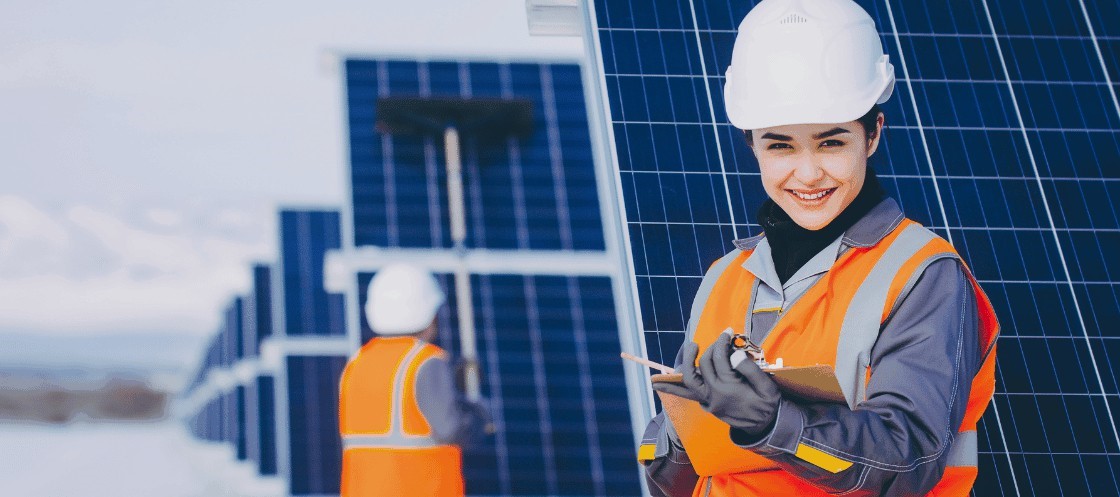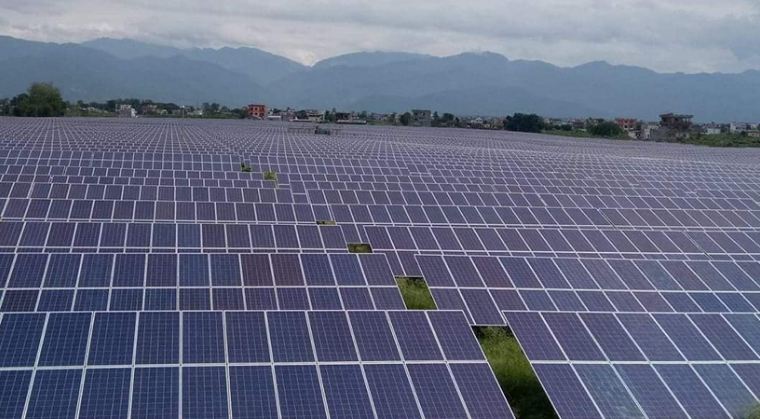Solar PV in Nepal: A Bright Future For Clean Energy

Around 20% of Nepal’s total energy consumption is made up of modern energy sources including electricity, petroleum, and renewables, and this percentage is steadily rising and can be attributed to Nepal’s brisk urbanization. Petrol use leads all sources of contemporary energy with a share of roughly 65% of overall consumption; electricity has a share of about 15%; and the remaining 20% is made up of other contemporary energy sources like coal and others[1]. The Government of Nepal (GoN) pledged at COP26 to attain net- zero emissions by 2045, but the goal now appears much more ambitious given the recent increase in the share of renewable energy sources. Hydropower is used to generate the majority of the nation’s electricity, and the majority of these sources are Run of River (RoR) types. The RoR type hydropower’s production highly depends upon the amount of rainfall in the country and has high seasonal fluctuation. Hence depending nation’s majority of electrical sources on a single source is dangerous and can cause catastrophic energy blackout. Solar PV a globally recognized and in trend in later decades is a promising technology which could secure the energy insecurity of Nepal. Solar PV comes into account in two major ways one, as cheap, green, and sustainable energy technology and another as diversifying the energy production in the country.
Energy security and independence
The first and most reasonable approach for promoting solar in Nepal is to increase the domestic energy generation. In Nepal, we do not have significant sources of petroleum which is dominating the proportion of modern energy usage in the country. The domestic consumption of electricity increases from 7,275 GWh in FY2020/21 to 8,823 in 2021/22 and at present total installed power plant capacity is 2265 MW, out of which, 74 MW from off-grid, and 2191 MW connected to grid. Among the grid connected generation facilities, 49.76 MW from solar, 53.4 MW from thermal, 6 MW is biomass, and the rest 2082 MW from hydro[2]. Off-grid isolated generation capacity of 74 MW developed through different sources by Alternative Energy Promotion Centre (AEPC) is also included in the installed capacity. The figure of total grid connected solar power generation add up to 87MW at the end of third quarter of 2023 among which
61MW is from IPPs and rest 26MW is from NEA. This makes solar PV the third largest source of electricity contributing nearly about 3% of the total grid connected electricity in Nepal and all the pipeline solar PV projects when completed contributes 5.03%, considering current generation from all other sources. Recently
40 solar plants got the license for surveying which could add 708 MW of grid connected generation facility in Nepal. This marks the acceleration of the development of solar power plants to meet the target to generate
1500-2250 MW of electricity of solar PV in 10 years.
According to Nepal Energy Outlook 2022, the country’s energy security is threatened by the trend of changing energy use for three reasons. First, even with the current level of import of modern fuels, cash outflow has exceeded the net income from all exports by the nation, which is alarming. Second, due to limited foreign currency reserves, Nepal may not be able to afford to buy and import the necessary quantity of modern fuels in the near future. Third, due to the depletion of natural reserves of modern fuels, especially the fossil fuels, prices of such fuels are skyrocketing in the international market and may be unaffordable soon. All of these call for increasing domestic energy output, making solar photovoltaic technology an excellent option to take into account. In recent years Nepal has become net importer to net exporter and along with that, NEA was able to increase the revenue and hence improve the financials of the organizations and the major credit goes to the recently commissioned projects including hydropower, solar power plants with transmission lines and other facilities. Witnessing the rapid development of electric generation in the country might seems well enough to satisfied but there might be some risk depending heavily on single source, as we have witnessed the rise, and fall of other technologies like the nuclear power in the 20’th century.
Solar PV as a viable solution
Solar power system is an energy generation system in which the energy of sun (the radiance energy) is converted to electrical energy which is done by solar module. A solar module is a modular device that consist of array of solar cells which are connected in combination of series and parallel connections. The power rating of a solar module varies but modules of 250wp to 450wp are widely used for residential, institutional as well as commercial solar PV system. Numbers of modules are connected together to form solar array which multiplies the current and voltage of a single solar module to generate adequate power to be supplied to the load directly or after converting to AC power. Generally, the DC power available is then converted to AC power and then supplied to the load however is small systems individual inverting units called microinverters are used. Since solar radiance is only available for certain hours a day, energy backup system is required to redeem the load requirement, in some cases energy is taken from the grid at the time of non-sun hours, in other cases battery or other storage systems are used which is generally called off-grid solar power plants.
The solar potential in Nepal is 50,000 terawatt-hours per year, which is 100 times larger than Nepal’s hydro resource and 7,000 times larger than Nepal’s current electricity consumption. According to a report by The Himalayan Times, the solar resource in Nepal is good enough for the production of electricity at a cost of NRs 4,800 (US$40) per MWh once the solar industry becomes mature in Nepal, falling to below NRs 3,600 (US$30)/MWh in 2030. In average the global solar radiation varies from 3.6-6.2 kWh/m2 day in Nepal. In a year, for about 300 days, sun shines. The number of sunshine hours amounts almost 2100 hours per year and average insolation intensity about 4.7 kWhm-2 day-1 (=16.92 MJ/m2 day) which makes Nepal’s geographical location a favorable insolation zone for harnessing solar energy[3].
Benefits
The major drawbacks of petroleum are the emission of greenhouse and other harmful gases which negatively affect the environment. As a renewable source of power, solar energy has an important role in reducing greenhouse gas emissions and mitigating climate change, which is critical to protecting humans, wildlife, and ecosystems. Solar energy can also improve air quality and reduce water use from energy production. Beside environmental benefits there are several economic benefits of solar power including quick return of investment (ROI), very low operating cost, low maintenance cost as there is no moving parts etc. Also, off grid solar system can electrify the rural parts where there is no access to grid electricity.
Government policies and initiatives
The government has been overseeing and supporting renewable energy projects through the Alternative Energy Promotion Centre (AEPC). AEPC provides information and awareness about alternative resources, provides financial assistance to promote renewable technologies, and advocates the use of alternative energies. Categories of solar PV systems are domestic (rooftop) PV for 500W to 10KW,
Institutional PV for 10KW to 500KW plants and commercial PV for more than 500KW capacity plants as mentioned on Grid Connected Alternative Energy Working Procedure 2074. Also assures the provision
for connection to national grid for all three categories of solar PV under capacity of 1MW systems after applying to NEA but prosumers do not need to apply in case of net metering. Any discounts and privileges are to be claimed through Alternative Energy Promotion Center (AEPC). For plants bigger than 1MW one year is given for the survey and must be completed and commissioned within two years and has the contract period of 25 years[4]. The supply of energy from any types of renewable energy is based on the concept of take or pay and has set the purchase rate of NPR 7.30 per unit[5], however Nepal Electricity Authority’s board meeting decided to conduct solar PPA through a competitive bidding process to make solar energy more accessible and competitive, following international trends which sets the purchase rate of NPR 5.94 per unit. The Renewable energy subsidy policy categorized into three regions, category A, category B and category C regions which gets the subsidies differently.
The Nepal Electricity Authority had previously entered into PPAs for 110.36 MW with 17 solar projects, out of which 85.26 megawatts are from the private sector, and 26 megawatts are from the authority, all connected to the national transmission line for solar energy. Recently 40 power plants ranging from 1MW to 250 MW in capacity got license for surveying which could add up to 708 MW. This approach seems to indicate the NEA and other Independent Power Producers (IPP)’s attraction towards solar energy as a viable alternative and a good investment.
Challenges and Solutions
Solar can play a significant role in balancing seasonal fluctuations in load demand in the country, however balancing the daily fluctuation can still be challenge since the technology have to heavily depend upon backup energy or storage system during non-sun hours. And the major challenge is lag in the technological development of storage systems specially battery technology to catch up with the accelerative development of solar panels. However, Nepal can benefit from its geography by constructing integrated solar and hydropower plants also known as Pumped Hydro Energy Storage System (PHES) are also constructed in several countries in the world China being at the top. In this system hydropower acts as storage unit for solar PV plant and the hydro machine (either RPT or PAT) can work as a pump or as a turbine working between upper and a lower reservoir. According to the Global Pumped Hydro Atlas, Nepal has 2,800 good storage sites, which is 50 times more than needed even after Nepal catches up with the developed countries.




